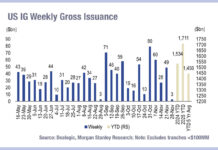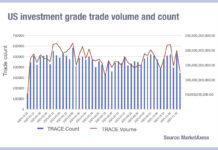Pre-trade data and market colour are imperative for buy-side traders looking to achieve best execution in corporate bond markets. Understanding how that applies to the execution of an order is not always straightforward. The three metrics for trading are price, time or speed, and size. Usually, two of these are possible to the detriment of the other, and the trader needs to assess which execution model to apply, based on the execution goal and their pre-trade information.
For any given bond there should be some known information: last traded price; dealer price feeds; predicted bid-ask spread from composite feeds; dealer axes; exchange-traded fund (ETF) pricing for indexed bonds, alerts on live offers via platforms; and volume data.
There will also be market conditions playing into trading activity, e.g. futures rolls, primary issuance and index rebalancing dates which might impact investor activity levels.
Discoverable pre-trade information includes: current offer prices where available – likely only via a request-for-quote (RFQ); comparable ISINs/CUSIPs and known data on them; dealer sentiment on providing balance sheet to the desk.
Of course, as with the ‘Observer Effect’ in physics, the very act of engaging with the market to gain discoverable information can affect the market itself, through information leakage.
A trade may be executed at this point with greater likelihood based on smaller size, more executable pre-trade dealer information, and more liquid instruments. Several forms of electronic credit trading protocols can facilitate a trade including automated execution based on fixed parameters or low touch execution ‘on click’ trading.
However, their use also depends upon the execution goals of the portfolio manager. The pre-trade liquidity picture of the credit market needs to be well aligned with execution goals of time/size/price before the decision on how to execute most effectively can be made.
One of the reasons a combination of auto-trading and portfolio trading (PT) is taking such a chunk of credit trading volume today is that both can deliver well on both time and price. By taking tight pricing in auto-trading and negotiated pricing for PT, each is able to facilitate trading at different ends of the liquidity curve, or more specifically PT can include less liquid as part of a trade to lessen the balance sheet impact of the sell side.
Increasingly, PT can be used to trade ever larger blocks of bonds within a list, so it can potentially take on size parameter too.
If the goal is to effect a trade at size, the trader often needs to engage with a counterparty to exchange a greater amount of information on trust for the bond(s) in question, before assessing the capability of the counterparty to price a large order.
If pre-trade information suggests it is an illiquid market for the bonds in question, pre-trade information around the best counterparty to reach out to is make or break – giving away a large trade position to a firm that doesn’t trade it is giving way valuable data.
In each instance it is the protocol selection that allow the trader to match their execution goal against the liquidity picture. The swathe of choices that bond traders have today to execute bond trades is precisely what has driven down the cost of liquidity in credit markets and boosted the productivity of the buy-side desk.
©Markets Media Europe 2025















